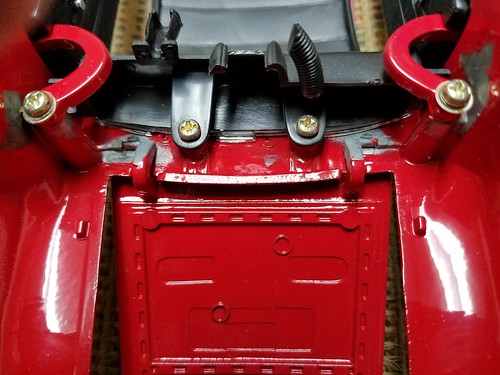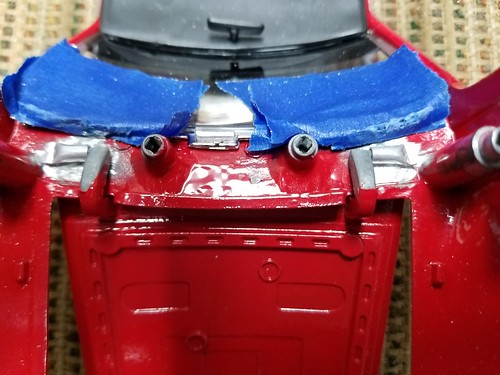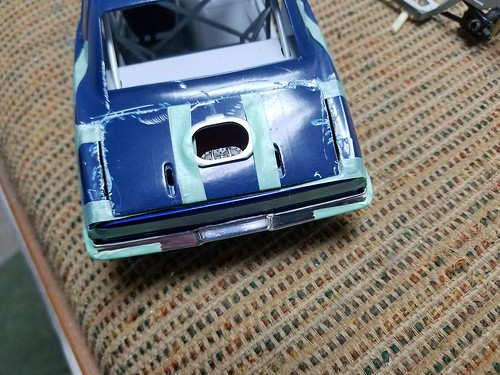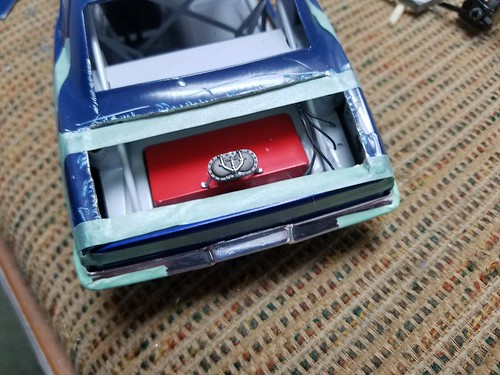So.... this might actually be best suited to a model building forum, but die-cast metal isn't a primary choice of builders, so I thought I would start here.
First of all, let me state my purpose in creating this thread: To identify the BEST ways to work with cutting and joining diecast metal.
I have plans for several custom builds, and for a variety of reasons (mostly related to subject matter availability) I find myself more and more interested in modifying diecast models. Some of these plans involve altering wheelbase, bed and cab configuration of pick-up truck model (lengthen or shorten) to make the models I am trying to depict, as the exact configurations have never been produced.
So I started with a bit of research on the forums and learned surprisingly little. Seems I might be venturing into territory that not many have ventured into, or at least it isn't well documented.
So here are a few things I have learned so far:
(From the diecast101 site)
Definition: The term refers to the process of forcing molten metal, under great pressure, into a die or form to give it a specific shape.
Die casting is rather expensive to set up, but can produce mass quantities of castings at relatively low, per piece cost. The forms, or tooling as it is usually referred to in the industry, can be very complex and often represents the largest cost associated with any given toy or model produced. The fine texture of the metal and the precision of the die can combine to create very detailed pieces when desired. The material used in diecast is actually a composition of zinc and aluminum sometimes referred to as 'zamac' inside the toy industry. It is not the same as steel or iron. Almost all die-cast toys and models have some plastic parts. For a more detailed discussion of die cast metal and the die cast process, please visit http://www.diecasting.org
OK, that's a start. At least I know what it's made of, but it didn't really tell me anything about hacking up my models to modify them..... What can I use to cut the body in half and re-attach it together, as if it never happened????
My initial gut feeling was that soldering using a brass backing plate would be the avenue I would experiment with if I found no information. Seems like this might be one preferred method for large modifications.
After searching around a while on Google, I stumbled across the following thread on another modelling forum:
http://www.rmweb.co.uk/community/index. ... ast-metal/
There's some good information on there about modifying old model trains
Lengthening Diecast Metal Body: What is the best way?
Re: Lengthening Diecast Metal Body: What is the best way?
Some of the other bodywork techniques I am aware of for working with diecast:
- Can cut the metal pretty easily. I have used small rotary tool with cutting wheel (dremel), I have used modelling razor saw, hacksaw blade, jigsaw, and even scribing tool or back of hobby blade to score along panel lines or slowly cut through a body.
- Fillers can be automotive or hobby grade. Generally the automotive types of body filler work best as they mix in two parts, dry fast and hard, do not shrink, and are pretty strong. Hobby grade fillers and glazing putty are best suited for small imperfections. JB Weld, reinforced epoxy putty, superglue with metal shavings (or other solids) can be used to fill / build up an area.
- Soldering. I haven't seen any real tutorials on model die-cast bodies yet, but there are some good youtube videos about soldering zinc or aluminum, and of doing repairs to "pot metal" and / or white metal. I am pretty confident in getting metal to stick together using this technique, but unsure about long term effects and possible oxidation / corrosion eventually attacking the joint. Any experts care to weigh in on soldering? Seems like high capacity iron, choosing the right solder / flux, and proper penetration and surface prep are all pretty important to getting a quality joint.
Adhesives. I know superglue and epoxies will work on some of this stuff, but I am not well versed in gluing these types of materials, so if anyone has any recommendations to offer, please feel free to share suggestions.
- Can cut the metal pretty easily. I have used small rotary tool with cutting wheel (dremel), I have used modelling razor saw, hacksaw blade, jigsaw, and even scribing tool or back of hobby blade to score along panel lines or slowly cut through a body.
- Fillers can be automotive or hobby grade. Generally the automotive types of body filler work best as they mix in two parts, dry fast and hard, do not shrink, and are pretty strong. Hobby grade fillers and glazing putty are best suited for small imperfections. JB Weld, reinforced epoxy putty, superglue with metal shavings (or other solids) can be used to fill / build up an area.
- Soldering. I haven't seen any real tutorials on model die-cast bodies yet, but there are some good youtube videos about soldering zinc or aluminum, and of doing repairs to "pot metal" and / or white metal. I am pretty confident in getting metal to stick together using this technique, but unsure about long term effects and possible oxidation / corrosion eventually attacking the joint. Any experts care to weigh in on soldering? Seems like high capacity iron, choosing the right solder / flux, and proper penetration and surface prep are all pretty important to getting a quality joint.
Adhesives. I know superglue and epoxies will work on some of this stuff, but I am not well versed in gluing these types of materials, so if anyone has any recommendations to offer, please feel free to share suggestions.
-
FrenchToast
- Posts: 53
- Joined: Thu Nov 10, 2016 9:43 pm
Re: Lengthening Diecast Metal Body: What is the best way?
I am definitely not an authority on the subject.
However, I did once research soldering metal pieces together and it seemed to me to be too involved and too risky in terms of getting the heat and application right. There is a youtube video somewhere of someone doing it on a diecast model. Perhaps if you have experience welding it may be easier. (Soldering diecast parts is far more involved than soldering electrical wires).
I have cut diecast metal, and would not recommend it to anyone. I once cut a very thick portion of a model and would prefer to not do it again.
"Diecast" metal as it is used in scale models, per my understanding, is mostly zinc. Zinc is extremely harmful. When cutting metal models you must use a respirator. Better yet, avoid cutting it.
But if cutting is the only way, I think something low speed, like a jeweler's hand saw, is better than a Dremel. The Dremel, with a high RPM grinding disc, makes a lot of very small dust particles that can be inhaled. A hand saw still makes dust particles, but it seems to be less?
I have used JB-Weld with success. I think I used a 'quick-set' version that was designed for metal-to-metal. (One tube has a black label, one a yellow label, for what that's worth. I don't have it in front of me.) In my case I bonded a custom aluminum part to an existing diecast part. The mating surfaces were roughed up, and it held very well. However, this was a simple spoiler and was not an entire body. I cannot speak for its performance in a more 'structural' application.
The JB-Weld can be sanded, however that too as I recall is pretty noxious. It is best to keep any 'overflow' epoxy to the not-visible portion of the body.
I chose 'quick-set' because the normal version required far too long a setting time - a few hours. The parts I mated were awkwardly shaped and very difficult to hold in place, at least for the period of time the normal epoxy required for setting.
Superglue is pretty poor at bonding metal to metal. It can bond plastic to metal with some success. However if it is done post-paintwork the glue must be applied very carefully. Any wayward superglue is difficult or impossible to remove without damaging the paint. Also, if you unknowingly get it on your fingers and then transfer it to paint, that is similarly hard to fix. Made that mistake on clear acrylic. Fingerprints on all of them, they all were tossed. Re-did them all while wearing gloves!
There is a recent thread about superglue on paint, user Zondaracer suggests an alternative to superglue.
However, I did once research soldering metal pieces together and it seemed to me to be too involved and too risky in terms of getting the heat and application right. There is a youtube video somewhere of someone doing it on a diecast model. Perhaps if you have experience welding it may be easier. (Soldering diecast parts is far more involved than soldering electrical wires).
I have cut diecast metal, and would not recommend it to anyone. I once cut a very thick portion of a model and would prefer to not do it again.
"Diecast" metal as it is used in scale models, per my understanding, is mostly zinc. Zinc is extremely harmful. When cutting metal models you must use a respirator. Better yet, avoid cutting it.
But if cutting is the only way, I think something low speed, like a jeweler's hand saw, is better than a Dremel. The Dremel, with a high RPM grinding disc, makes a lot of very small dust particles that can be inhaled. A hand saw still makes dust particles, but it seems to be less?
I have used JB-Weld with success. I think I used a 'quick-set' version that was designed for metal-to-metal. (One tube has a black label, one a yellow label, for what that's worth. I don't have it in front of me.) In my case I bonded a custom aluminum part to an existing diecast part. The mating surfaces were roughed up, and it held very well. However, this was a simple spoiler and was not an entire body. I cannot speak for its performance in a more 'structural' application.
The JB-Weld can be sanded, however that too as I recall is pretty noxious. It is best to keep any 'overflow' epoxy to the not-visible portion of the body.
I chose 'quick-set' because the normal version required far too long a setting time - a few hours. The parts I mated were awkwardly shaped and very difficult to hold in place, at least for the period of time the normal epoxy required for setting.
Superglue is pretty poor at bonding metal to metal. It can bond plastic to metal with some success. However if it is done post-paintwork the glue must be applied very carefully. Any wayward superglue is difficult or impossible to remove without damaging the paint. Also, if you unknowingly get it on your fingers and then transfer it to paint, that is similarly hard to fix. Made that mistake on clear acrylic. Fingerprints on all of them, they all were tossed. Re-did them all while wearing gloves!
There is a recent thread about superglue on paint, user Zondaracer suggests an alternative to superglue.
Re: Lengthening Diecast Metal Body: What is the best way?
Thanks for the information, FrenchToast.
I agree with your caution on safety: I wear eye protection and mask when cutting metal using a rotary tool. I try to avoid high speed cutting where possible, and go by hand, but sometimes it is necessary.
on adhesives: I have tried JB weld, as well as fiber re-inforced epoxy putty for other jobs. Just never on a diecast. My concern is that the join line eventually forms a crack through the paint after everything is completed. But it might be the simplest option. I dont want to put in all the work only to see ghosted panel line cuts after it is all done. Hopefully someone knows.........
That is one of the reasons I am (for now) interested in all-metal joints like soldering, if possible. I've worked with structural soldering before, on sheet metal projects, and have soldered brass rod and sheet with building on a couple previous modeling projects where I needed both thinner parts and strength.
I have found a product called "muggy weld" which seems to be targeted towards pot metal, white metal repairs, and might work on diecast car bodies? Looks promising, but is very expensive as far as solder goes. Wondering if any other particular type of solder would be more economical and still do the job well. As far as stretching panels, thinking of using a second body (cut up as required) or possible fabrication of panels made of brass, soldered and filled in
I agree with your caution on safety: I wear eye protection and mask when cutting metal using a rotary tool. I try to avoid high speed cutting where possible, and go by hand, but sometimes it is necessary.
on adhesives: I have tried JB weld, as well as fiber re-inforced epoxy putty for other jobs. Just never on a diecast. My concern is that the join line eventually forms a crack through the paint after everything is completed. But it might be the simplest option. I dont want to put in all the work only to see ghosted panel line cuts after it is all done. Hopefully someone knows.........
That is one of the reasons I am (for now) interested in all-metal joints like soldering, if possible. I've worked with structural soldering before, on sheet metal projects, and have soldered brass rod and sheet with building on a couple previous modeling projects where I needed both thinner parts and strength.
I have found a product called "muggy weld" which seems to be targeted towards pot metal, white metal repairs, and might work on diecast car bodies? Looks promising, but is very expensive as far as solder goes. Wondering if any other particular type of solder would be more economical and still do the job well. As far as stretching panels, thinking of using a second body (cut up as required) or possible fabrication of panels made of brass, soldered and filled in
Re: Lengthening Diecast Metal Body: What is the best way?
Great topic, would love to join in, but traveling outside my country right now with limited resources to allow me to properly respond.
Will be in country by the weekend, and will post then.
Will be in country by the weekend, and will post then.
Re: Lengthening Diecast Metal Body: What is the best way?
Looking forward to hearing more discussion on the topic!!Oldtimer wrote:Great topic, would love to join in, but traveling outside my country right now with limited resources to allow me to properly respond.
Will be in country by the weekend, and will post then.
Re: Lengthening Diecast Metal Body: What is the best way?
Back in country, and will start with just a couple of photos of projects where I have put pieces together to make a custom (or repair a screw-up).
First, this double length trailer (would be a similar technology to lengthening a chassis).


I use hobby-sized nuts and bolts, these are 0-80; the other common size I use is 00-90. These are readily available in a number of head shapes (screws versus nuts), as well as lengths.
Second, this repair of a screw up on my part, where I extended a hinged opening too far open. This hood was held on with a clamp-type application where the diecast metal was crimped over the hinge pins.

I formed two tubes out of aluminum stock of the right ID/OD, and then JB Welded them to the original body location.


I am an avid user of JB Weld, I love how you can work it with a Dremel.
It was pointed out above about how to open up doors, etc, which are fixed or molded in. I use a very sharp and hardened steel awl, to scratch on the outer outline of the opening, and then once I have sufficient depth (this can sometimes take a while), I grind off the diecast on the backside until an opening begins to appear.
Here I am creating an opening trunk where the original model was solid.


I know it looks rough, but I will finsh the edges (probably with JB Weld, to get a nice, consistent panel gap.
I don't have a good picture right now, but the other thing I use to join pieces is very small wire (such as paper clips). I drill a hole about the same size (a pin vice is a great investment, as is an inexpensive micrometer), insert on the pin (usually with a dab of SuperGlue), line up the two pieces, drill another hole, and SuperGlue the two pin locations. Seams can be filled in with, you guessed it, JB Weld, and then the pieces can be smoothed and worked accordingly. This is the technique I would suggest if you are joining body pieces together to stretch a model body.
Enough at this time, just thought I'd throw out some of my approaches, and I would love to help you out in any way possible.
First, this double length trailer (would be a similar technology to lengthening a chassis).


I use hobby-sized nuts and bolts, these are 0-80; the other common size I use is 00-90. These are readily available in a number of head shapes (screws versus nuts), as well as lengths.
Second, this repair of a screw up on my part, where I extended a hinged opening too far open. This hood was held on with a clamp-type application where the diecast metal was crimped over the hinge pins.

I formed two tubes out of aluminum stock of the right ID/OD, and then JB Welded them to the original body location.


I am an avid user of JB Weld, I love how you can work it with a Dremel.
It was pointed out above about how to open up doors, etc, which are fixed or molded in. I use a very sharp and hardened steel awl, to scratch on the outer outline of the opening, and then once I have sufficient depth (this can sometimes take a while), I grind off the diecast on the backside until an opening begins to appear.
Here I am creating an opening trunk where the original model was solid.


I know it looks rough, but I will finsh the edges (probably with JB Weld, to get a nice, consistent panel gap.
I don't have a good picture right now, but the other thing I use to join pieces is very small wire (such as paper clips). I drill a hole about the same size (a pin vice is a great investment, as is an inexpensive micrometer), insert on the pin (usually with a dab of SuperGlue), line up the two pieces, drill another hole, and SuperGlue the two pin locations. Seams can be filled in with, you guessed it, JB Weld, and then the pieces can be smoothed and worked accordingly. This is the technique I would suggest if you are joining body pieces together to stretch a model body.
Enough at this time, just thought I'd throw out some of my approaches, and I would love to help you out in any way possible.

